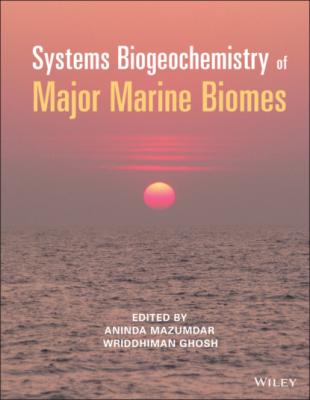Systems Biogeochemistry of Major Marine Biomes. Группа авторов
Чтение книги онлайн.
Читать онлайн книгу Systems Biogeochemistry of Major Marine Biomes - Группа авторов страница 40

Figure 3.5 Dissolved iron concentrations and depth stratification in community composition in Baltic Sea sediments: (a) Skagerrak; (b) Bothnian Bay. Decreasing relative contribution of iron reduction to overall dissimilatory microbial activity is schematically indicated. Relative abundance of potential iron‐reducing groups (b and e) tend to decrease with depth, while other groups (c and f) increase. A deviation of the trend occurs at the Bothnian Bay site, at 5 cm, which is probably due to a layer of freshly deposited marine organic matter.
Modified from Reyes et al. (2016) and reproduced with permission from Oxford University Press.
The observed depth‐zonation of the microbial community can be explained in the geochemical context. In sediments from Site Geo2a in the Skagerrak, containing moderate amounts of reactive organic matter, dissolved iron(II) is present in the porewater (Figure 3.5; Reyes et al. 2016). Sulfate concentrations are also constant with depth, while constant δ34S and δ18O values of sulfate suggest that sulfide is not re‐oxidized to sulfate. It is possible that, due to limitation in organic substrates, iron(III) is initially the dominating electron acceptor, but diminished availability of iron(III) may lead to a shift from iron reducers to sulfate reducers with depth in these sediments. Fermenters that are known to donate their electrons to iron(III) are also observed in the iron‐reduction zone, including Clostridiaceae, Bacillaceae, and Rhodobacteraceae. Their abundance remains constant with depth, matching the persistent availability of organic carbon.
A similar distribution of iron reducers with depth was observed in sediments from Site At4 in the Bothnian Bay (Reyes et al. 2016). Dissimilatory iron reducers, including Desulfobacter, Geobacter, Desulfobulbaceae, Desulfuromonadaceae, and Pelobacteraceae had a higher abundance near the surface of the sediment and their abundances decreased with depth (Figure 3.5). In addition, Clostridiaceae and Bacillaceae abundances decreased with depth. In contrast, Desulfobacteraceae, Desulfobacterium, and Desulfococcus had a higher abundance at greater depths. The high abundance of Geobacter at the surface and the higher abundance of the sulfate‐reducing bacterium Desulfococcus at greater depths suggests that near the top of the sediment iron reduction is the dominant process, whereas sulfate reduction becomes more important with depth. As indicated by a high C/N ratio, organic matter at this site is mainly derived from terrestrial plant material and is thus more refractory compared with the Skagerrak. However, near the surface, a layer of marine derived organic matter occurs, probably as a result of an algal bloom, which is evidently capable of fuelling sulfate reduction. At the same time iron is abundant (~1 wt%) and most probably reactive, so that iron reduction and sulfate reduction may overlap. The decrease in the fermenters with depth reflects the decrease in organic matter reactivity.
Several other studies used next generation sequencing to identify active iron‐cycling microorganisms in marine surface sediments. Otte et al. (2018) detected Desulfobulbus (1–4%), Desulfobacterium (0.1–0.2%), Geobacter (0.1–0.2%), and Shewanella (0.1–1%) in sediments of Norsminde Fjord and Kalø Vig (Denmark), but these organisms occurred at all depths and their presence was not related to the geochemical zones. In the study by Li et al. (2019), Shewanella was highly abundant (4.4%) in a layer where iron(III) and sulfate reduction co‐occurred (at 330 cm). Nevertheless, the latter studies proposed only a hypothetical involvement of observed organisms in iron reduction without relation to the geochemical context.
3.4.3. Methanogenic Zones
In the methanogenic zone, where both sulfate and sulfide are depleted, AOM may be linked to the reduction of iron, a process termed Fe‐AOM. This was suggested based on experiments with flow‐through reactors using sediments recovered from Juan de Fuca Ridge (Wankel et al. 2012). The presence of green rust and other mixed‐valance iron oxides in these high‐temperature incubations at 90°C suggested that AOM could be coupled to iron reduction. Based on pyrosequencing and qPCR, members of the archaeal group ANME‐1, including ANME‐1c, were abundant and, thus, were likely to contribute to methane oxidation. Egger et al. (2015) observed enhanced oxidation of 13C‐labelled methane in the presence of iron(III) nanoparticles in incubations with sediments from a methanogenic zone of the Bothnian Sea, suggesting that iron‐reduction was linked to methane oxidation. Ettwig et al. (2016) showed that enrichment cultures of a new group within the Methanosarcinales termed AOM‐associated archaea (AAA), and sometimes referred to as ANME‐2d, can couple the oxidation of methane to the reduction of iron and manganese oxides. Control incubations without methane did not produce Fe2+, indicating that no alternative carbon source was used. Furthermore, based on incubation experiments with 13C‐labelled methane, Scheller et al. (2016) suggested that ANME‐2a and ANME‐2c could also be capable of reducing insoluble iron oxides and that AOM is decoupled from sulfate reduction. An in‐situ study in sediment from the methanogenic zone of the Helgoland mudflat area in the North Sea was performed by Oni et al. (2015), using pyroseqeuncing and 16S rRNA qPCR. This site showed high concentrations of dissolved Fe2+ in the methanogenic zone. High abundances of the bacterial candidate division JS1 (SB45 lineage) and Methanohalobium ANME‐3 archaea were detected in the methanogenic zone with free Fe2+ in the porewater, suggesting that they could be involved in iron reduction (Oni et al. 2015). Alternatively also Desulfuromonadales